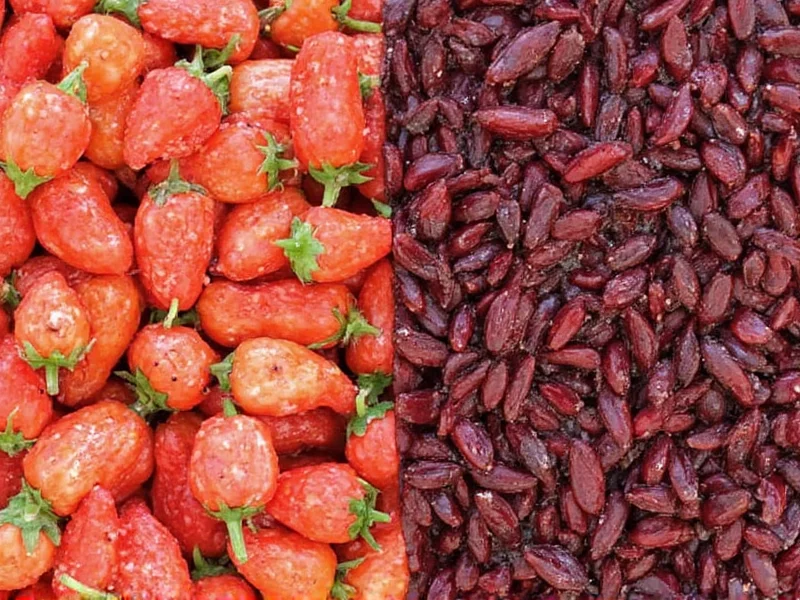Understanding the differences between guajillo vs pasilla chilies is crucial for authentic Mexican cooking. These two dried peppers often appear in traditional recipes but serve distinct culinary purposes. Let's explore their characteristics to help you choose the right pepper for your dishes.
Physical Characteristics Comparison
Guajillo and pasilla peppers have distinctive appearances that make them relatively easy to identify once you know what to look for.
| Characteristic | Guajillo Pepper | Pasilla Pepper |
|---|---|---|
| Originating Fresh Pepper | Mirasol | Chilaca |
| Color (Dried) | Reddish-brown, mahogany | Dark brown to black ("chile negro") |
| Shape | Long, smooth, 3-6 inches, 1-2 inches wide | Long, wrinkled, 6-8 inches, 1-1.5 inches wide |
| Texture | Smooth, leathery skin | Rough, deeply wrinkled skin |
| Seeds | Light tan, flat | Dark brown, rounded |
Flavor Profiles and Heat Levels
The most significant differences between guajillo vs pasilla appear in their flavor profiles and heat intensity.
Guajillo Flavor Profile
Guajillo peppers deliver a complex flavor that combines:
- Tangy, almost cranberry-like acidity
- Subtle berry notes
- Green tea undertones
- Mild earthiness
- Medium heat (2,500-5,000 Scoville Heat Units)
When toasted properly, guajillos develop a pleasant fruitiness without overwhelming heat, making them versatile for various applications.
Pasilla Flavor Profile
Pasilla peppers offer a dramatically different experience:
- Deep, smoky richness
- Prominent dried fruit notes (raisin, prune)
- Subtle licorice undertones
- Earthy complexity
- Milder heat (1,000-2,500 Scoville Heat Units)
Pasillas provide foundational depth in darker sauces without dominating with heat, which explains their role in classic mole negro.
Culinary Applications: When to Use Guajillo vs Pasilla
Understanding proper usage separates authentic Mexican cooking from mere approximation. These peppers rarely substitute for one another without altering a dish's character.
Best Uses for Guajillo Peppers
Reach for guajillo peppers when you need:
- Bright red color in sauces (like adobo or ranchero)
- Moderate heat with fruity complexity
- Salsas that balance acidity and warmth
- Marinades for lighter meats like chicken or pork
- Traditional dishes: Chile Colorado, Enchiladas Rojas, certain mole varieties
Chefs often toast guajillos lightly before rehydrating to enhance their natural fruitiness without developing excessive bitterness.
Best Uses for Pasilla Peppers
Choose pasilla peppers when creating:
- Dark, complex mole sauces (especially mole negro)
- Rich adobos with deep color
- Dishes requiring smoky depth without intense heat
- Recipes featuring chocolate or dried fruit elements
- Traditional dishes: Mole Poblano (as part of the trinity), pipián sauces
Pasillas form the backbone of Mexico's darkest, most complex sauces, where their raisin-like sweetness balances other intense flavors.
Substitution Guidance
While not ideal, substitutions become necessary when specific peppers are unavailable. Consider these alternatives:
Guajillo Substitutes
- Ancho peppers (milder, sweeter, less tangy)
- Cascabel peppers (similar heat, nuttier profile)
- Combination of New Mexico chilies with a touch of cumin
Pasilla Substitutes
- Mulato peppers (similar but slightly sweeter)
- Ancho peppers with a touch of smoked paprika
- Combination of ancho and chipotle for smokiness
Remember that pasilla has no perfect substitute due to its unique flavor profile. When substituting in guajillo vs pasilla recipes, adjust other ingredients to compensate for flavor differences.
Availability and Storage
Both peppers appear in well-stocked grocery stores, Latin markets, and online retailers, but their availability varies by region.
Purchasing Tips
- Look for pliable peppers without excessive brittleness
- Avoid peppers with mold spots or excessive dust
- Fresh guajillos should have a deep reddish-brown hue
- Quality pasillas appear nearly black with deep wrinkles
- Smell test: Both should have pleasant, complex aromas without mustiness
Proper Storage Methods
Maximize shelf life by:
- Storing in airtight containers away from light and moisture
- Keeping in a cool, dark pantry (6 months)
- Refrigerating for extended storage (up to 1 year)
- Freezing for maximum longevity (up to 2 years)
- Grinding into powder only as needed for best flavor retention
Traditional Preparation Techniques
Proper preparation significantly impacts the final flavor in guajillo vs pasilla applications.
Rehydrating Dried Peppers
- Remove stems and shake out most seeds (keep some for heat control)
- Lightly toast on dry skillet for 15-20 seconds per side until fragrant
- Submerge in hot water for 15-20 minutes until pliable
- Blend with soaking liquid for smooth sauces
Never boil dried chilies, as this extracts bitterness. The soaking liquid contains valuable flavor compounds, so incorporate it into your sauces.
Heat Management Tips
- Remove all seeds and white membranes for milder flavor
- Retain some seeds for increased heat complexity
- Guajillos generally provide more consistent heat than pasillas
- Always taste test rehydrated peppers before adding to recipes
Signature Dishes Featuring Each Pepper
Understanding traditional applications helps clarify the guajillo vs pasilla distinction.
Guajillo-Forward Dishes
- Chile Colorado: Rich beef stew featuring guajillo-based sauce
- Salsa de Chile Guajillo: Simple roasted tomato and guajillo salsa
- Adobo Sauce: Guajillo forms the base for many regional adobos
- Enchiladas Rojas: Traditional red enchilada sauce
Pasilla-Forward Dishes
- Mole Negro: Oaxacan specialty where pasilla provides foundational flavor
- Pipián Verde con Pasilla: Pumpkin seed sauce enhanced with pasilla
- Chiles en Nogada: Often includes pasilla in the complex sauce
- Traditional Mexican Adobos: Particularly darker, richer varieties
Common Misconceptions
Several misunderstandings persist about these peppers:
- Misconception: Pasilla is just a darker guajillo
Reality: They come from completely different fresh peppers (chilaca vs mirasol) - Misconception: They can be used interchangeably
Reality: Substituting one for the other significantly alters flavor profiles - Misconception: Pasilla means "little raisin" referring to size
Reality: The name refers to flavor, not size (pasilla = "little raisin" in Spanish) - Misconception: Guajillo is always hotter than pasilla
Reality: Heat varies by crop, but guajillo typically ranges higher on the Scoville scale











 浙公网安备
33010002000092号
浙公网安备
33010002000092号 浙B2-20120091-4
浙B2-20120091-4